Databricks: Everything You Need to Know
Alina Boz
Subscribe to our newsletter
Get the latest updates, insights, and growth tactics from AddGuestPost in your inbox.

If you’ve been anywhere near the data or AI world recently, you’ve probably heard the name Databricks. But what exactly is it, and why is everyone talking about it?
Whether you’re a data engineer, a business analyst, or someone simply curious about the future of data platforms, this guide will walk you through everything you need to know about Databricks—in plain, human language.
💡 What is Databricks?
Databricks is a cloud-based platform designed to unify data engineering, data science, machine learning, and analytics. It helps organizations process massive amounts of data quickly and collaborate on building AI models—all in one place.
It was founded by the creators of Apache Spark, which explains its deep roots in large-scale data processing.
🚀 Why is Databricks So Popular?

The main reason Databricks is gaining so much attention is because it solves a major pain point: fragmented data workflows. Instead of juggling different tools for ingestion, storage, analytics, and machine learning, Databricks brings it all together in a single environment.
Some key advantages include:
- Unified workspace for teams
- Support for multiple languages (Python, SQL, R, Scala)
- Built-in machine learning tools
- Native integration with AWS, Azure, and Google Cloud
- Enterprise-grade security and compliance
🔧 Key Features of Databricks
Here are some standout features that make Databricks a go-to solution:
1. Delta Lake
Databricks’ Delta Lake adds reliability and performance to your data lakes. It brings ACID transactions, scalable metadata handling, and data versioning to your lakehouse.
2. Databricks Notebooks
Interactive and collaborative notebooks where teams can write code, visualize data, and document everything in one place.
3. MLflow Integration
Databricks includes MLflow, a popular open-source platform for managing the ML lifecycle—experiment tracking, model management, and deployment.
4. Auto-scaling and Clusters
No need to worry about infrastructure—Databricks can automatically scale clusters up or down based on workload.
5. SQL Analytics
For those who love SQL, Databricks offers a clean interface to run complex queries, build dashboards, and connect with BI tools like Tableau and Power BI.
🌍 Who Uses Databricks?

Databricks is used by thousands of companies worldwide—from startups to Fortune 500 giants. Its versatility makes it a solid choice across industries, including finance, healthcare, retail, and tech.
Whether it’s predicting stock trends, optimizing supply chains, or building recommendation engines, Databricks is powering real-world innovation.
🛠 Use Cases of Databricks
- Data Engineering Pipelines
Automate ETL workflows and handle big data at scale. - Machine Learning & AI
Train and deploy models using integrated ML tools. - Business Intelligence
Run fast SQL queries and visualize your data. - Streaming Data
Handle real-time data from IoT devices or apps. - Data Lakehouse Architecture
Combine the best of data lakes and warehouses in one system.
🤝 Databricks vs. Snowflake
A common comparison in the data world is Databricks vs. Snowflake. While Snowflake focuses more on data warehousing and SQL analytics, Databricks is stronger in AI, machine learning, and engineering-heavy workflows.
If your organization is deeply invested in AI or custom data pipelines, Databricks might be the better choice.
🧠 Learning Databricks
The good news? You don’t need to be a data wizard to get started with Databricks. They offer extensive documentation, online courses, and even certifications.
Whether you’re a beginner or a seasoned pro, there’s always more to learn—and Databricks makes it easy to level up.
🧩 Final Thoughts
Databricks isn’t just another data tool—it’s an ecosystem built for collaboration, scale, and innovation. It helps teams work smarter, not harder, by centralizing the messy world of data into a clean, powerful platform.
If you’re working with data and haven’t explored Databricks yet, now’s the time. It might just change how your team handles data forever.
Publish Your Blog on This Space
AddGuestPost.com welcomes guest bloggers to contribute content across a variety of categories. If you believe your content can bring value to our community, we’d love to have you on board!
Related Posts
Best AI Tools to Generate Video from Image
Latest Technology and AI Trends: How They Are Changing Our World
How Blockchain Technology is Revolutionizing the Financial Sector
Categories
Categories
Advertise
here
Publish Your Blog on This Space
AddGuestPost.com welcomes guest bloggers to contribute content across a variety of categories. If you believe your content can bring value to our community, we’d love to have you on board!